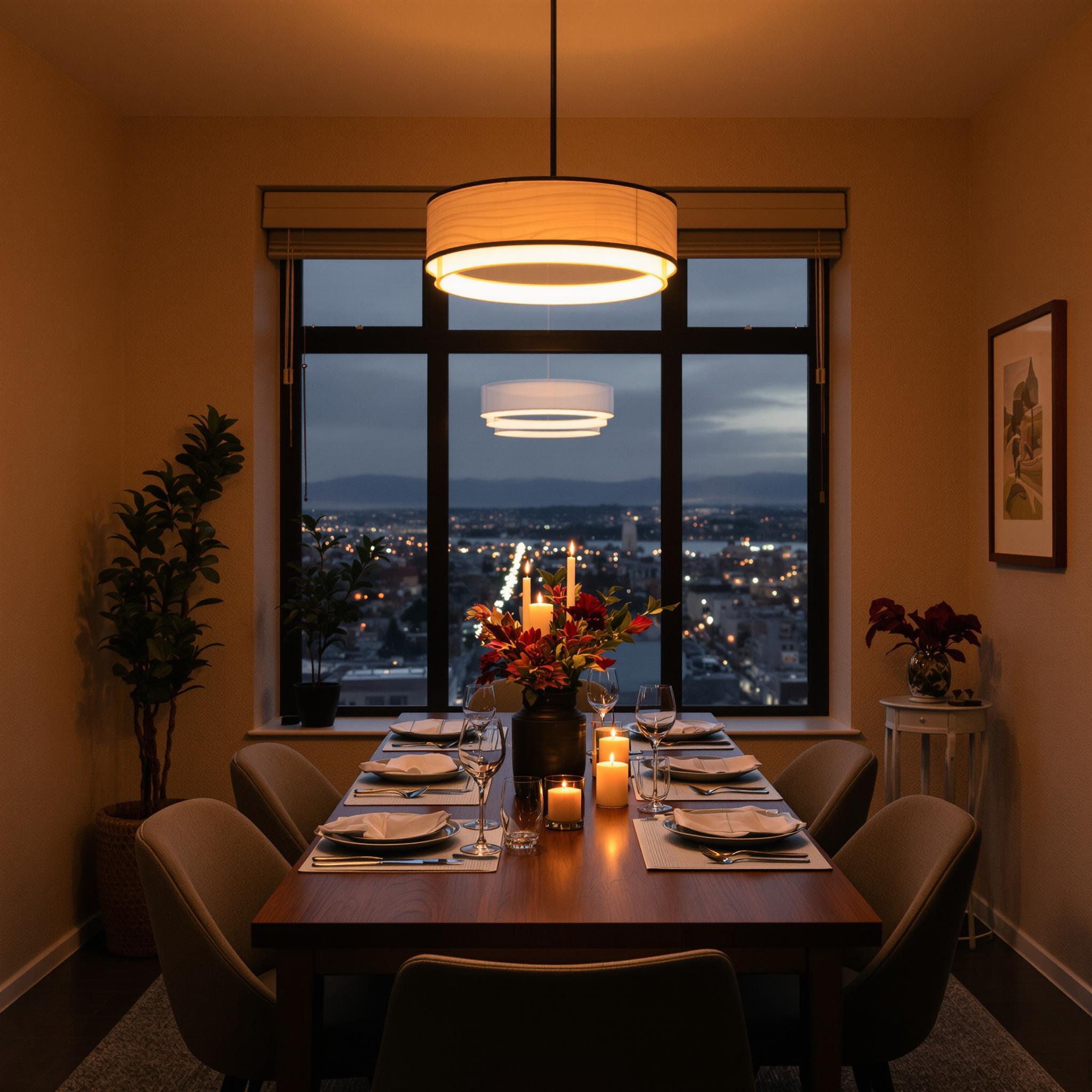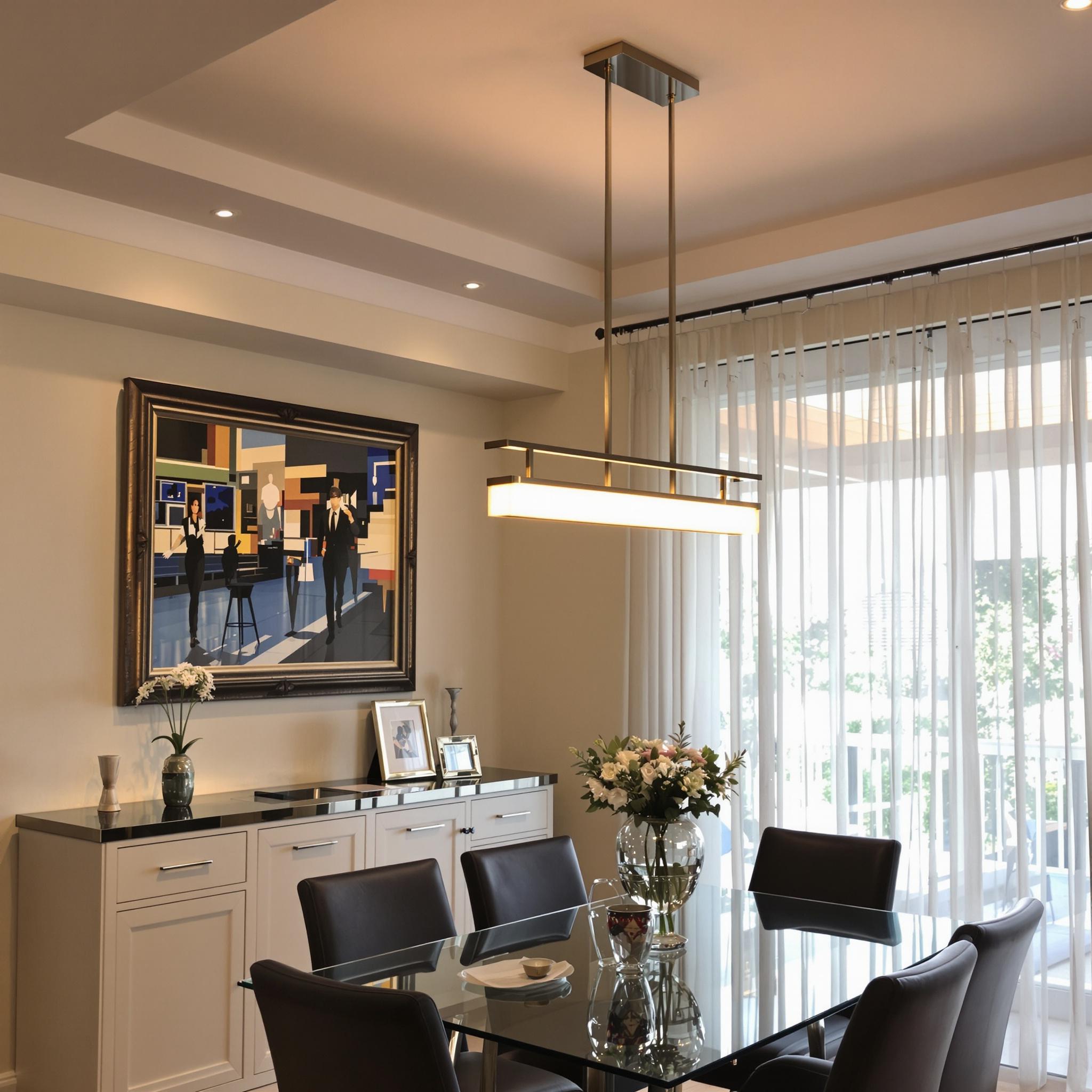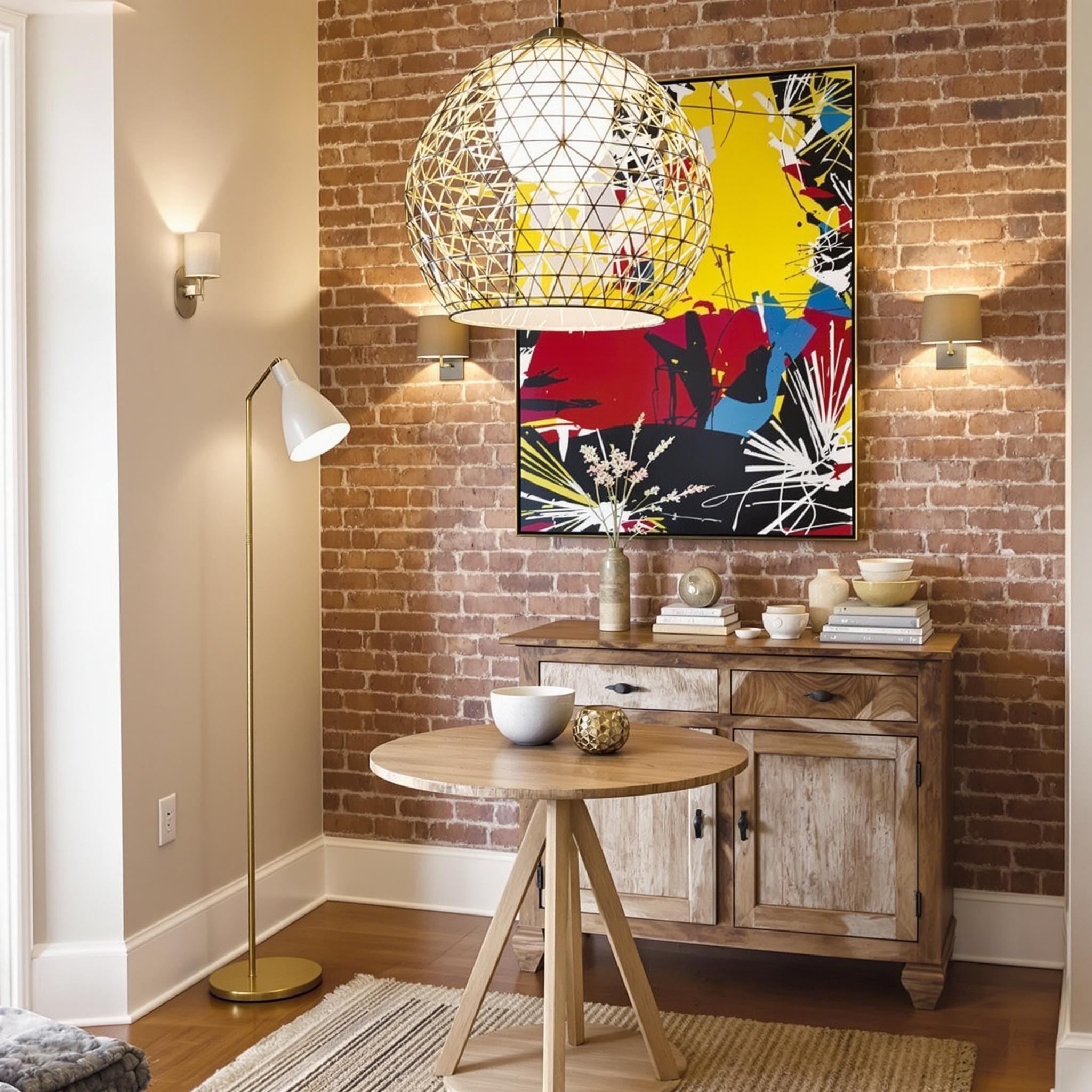Why Dining Room Lighting Matters
Lighting shapes how a dining room feels and works. It’s not just about brightness.
Imagine this: soft light over a table, laughter filling the room. That’s the power of good lighting. Harsh lights can ruin meals. Dim ones make people squint. The right balance creates warmth and comfort.
Light affects mood and focus. Bright lights energize. Soft lights calm. In dining spaces, you want both. A cozy vibe for dinner, but enough light to see your food.
Think about shared meals. Lighting sets the tone. Romantic dinners need dim lights. Family meals work best with balanced lighting. Guests notice it, even if they don’t say so.
Key Factors in Choosing Dining Room Lights
Picking the right fixture isn’t guesswork. Start with room size. Small rooms need smaller fixtures. Large rooms handle bigger lights or multiple ones.
Ceiling height matters too. High ceilings suit pendant lights. Low ceilings need flush mounts. Measure carefully before buying.
Style ties the room together. Modern fixtures pair well with sleek furniture. Rustic lights match wooden tables. Choose pieces that fit your home’s look.
- Room size: Match fixture scale to space.
- Ceiling height: Ensure proper clearance above tables.
- Style: Align with existing decor.
Pro tip: Bring a photo of your dining area when shopping. It helps visualize the result.
How Lighting Affects Mood and Function
Light changes how we feel. Warm tones feel inviting. Cool tones feel crisp. Pick colors wisely.
Warm white lights are perfect for dining. They mimic candlelight. This makes people relax. Cooler lights work better in kitchens or task areas.
Bright lights help during prep. Dim lights aid conversation. Adjustable fixtures give flexibility. Use dimmers to switch between settings.
Ever felt uneasy in a harshly lit room? That’s bad lighting at work. Balance is key. Aim for layers of light instead of one bright source.
Types of Lighting and Their Roles
Three types of lighting matter in dining spaces: ambient, task, and accent. Each has a job.
Ambient lighting is the base layer. It fills the room with soft glow. Chandeliers or ceiling lights often provide this.
Task lighting focuses on specific areas. Over a buffet table or sideboard, it’s useful. Spotlights or track lights work here.
Accent lighting highlights features. Picture frames, art, or decor items shine with this. Use wall sconces or directional spots.
- Ambient: General illumination for overall brightness.
- Task: Focused light for practical tasks.
- Accent: Decorative light to showcase details.
Combine all three for depth. For example, pair a chandelier with under-cabinet lights. Add a spotlight on a piece of art.
Remember: lighting isn’t static. Change it as needed. Dinners, parties, and quiet nights call for different setups.
Practical Tips for Better Lighting Choices
Start by mapping your room. Note where people sit and move. Avoid shadows over the table.
Hang fixtures at the right height. Bottom of the light should be 30-36 inches above the table. Too high, it loses impact. Too low, it blocks sightlines.
Consider bulb types. LED bulbs save energy. They also come in various color temps. Choose 2700K-3000K for warm tones.
Test before you buy. Many stores let you see samples. Look at how light spreads. Check if it flickers or hums.
Don’t forget natural light. Windows add daytime brightness. Use sheer curtains to soften glare.
Layer your lighting. A mix of sources adds interest. Try a chandelier, wall sconces, and table lamps. Control them separately with switches.
Story time: I once picked a giant chandelier. It looked stunning in the store. At home, it overwhelmed my small dining space. Lesson learned—measure twice!
Chandeliers: Styles, Sizes, and How to Choose the Right One for Your Space
Let’s talk chandeliers. They’re those eye-catching centerpieces that can make a room feel luxurious. But not all chandeliers are the same. You’ve got classic crystal ones, modern minimalist designs, and everything in between.
I once had a client who put a huge, fancy chandelier in a tiny dining nook. It was beautiful but way too much—like wearing a ball gown to grab coffee. The lesson? Size matters. A good rule is to measure your table’s width and subtract 12 inches. That gives you the right chandelier diameter. For example, if your table is 48 inches wide, aim for a 36-inch chandelier. Don’t forget height either. The bottom of the chandelier should hang 30-36 inches above the table. Any lower, and people might bump their heads.
Choosing a style isn’t just about looks. Think about the vibe you want. Traditional homes might suit intricate designs or vintage-inspired pieces. If you prefer modern, go for clean lines or industrial materials like blackened steel or brushed brass. Mixing metals is trendy now, but keep it balanced. Repeat the metal tone in other parts of the room, like cabinet knobs or frames.
Pendant Lights: Versatility, Placement Tips, and Design Ideas
Now let’s talk pendant lights. These are versatile and work in almost any space. I helped a friend redo her small studio apartment. We hung three mismatched pendants over her breakfast bar. It added style without costing a fortune.
Placement is key. Over a dining table, hang them in odd numbers—like one, three, or five—for balance. Keep them evenly spaced and at least 30 inches apart. If you have high ceilings, group multiple pendants at different heights. This creates a cascading effect that adds drama. Trust me, it works wonders.
Pendant designs are endless. Love farmhouse style? Try woven rattan shades or glass fixtures with Edison bulbs. Into mid-century modern? Look for globe shapes or warm wood accents. Oversized pendants can be statement pieces too. Imagine walking into a room where one bold pendant dominates—it’s unexpected but captivating.
Flush and Semi-Flush Mounts: Best Uses and Design Considerations
Here’s the truth: I used to think flush and semi-flush mounts were boring. Then I worked on a project with low ceilings, and they became my go-to. These fixtures sit close to the ceiling, making them perfect for tight spaces.
Sure, they may not scream “wow,” but modern versions have cool details. Frosted glass, scalloped edges, or fabric wraps can make them stand out. Semi-flush mounts add a bit more depth with short stems or decorative arms. In small dining areas, they provide plenty of light without taking up too much visual space.
Proportion matters. Even though these fixtures hug the ceiling, they still need to match the size of the table or seating area below. Too small, and they disappear. Too big, and they overwhelm. Aim for a diameter that’s about half the width of your table. For a 60-inch table, a 28-30 inch fixture works well.
Recessed Lighting and Track Lighting: Modern Approaches and Layering Techniques
Let’s talk recessed lighting and track lighting. Some people think recessed lights feel cold, but they don’t have to. When done right, they create a cozy, layered look. Think of them as support players—they set the stage for other fixtures to shine.
Track lighting is having a moment. Today’s models are sleek and customizable. I convinced a client to try track lighting in their open-concept dining area. Six months later, they texted me saying how much they loved adjusting the spotlights to highlight artwork or mood-setting corners.
Layering is key. Start with recessed lights for general lighting. Add track lights or pendants for task and accent lighting. Throw in a dimmer switch for mood control. Layering makes the space more functional and adds depth. Honestly, it’s an easy way to give your dining room a glow-up.
Unique and Creative Options Like Wall Sconces or Statement Pieces
Finally, let’s talk about wall sconces and statement pieces. These aren’t your typical dining room fixtures, but they make a big impact. Wall sconces mounted on either side of a buffet bathe the walls in soft light. Plus, they free up ceiling space if you already have a chandelier or pendant.
Statement pieces are where things get fun. Picture a sculptural floor lamp in the corner or a dramatic candelabra-style fixture above the table. These choices make guests stop and say, “Wow.” Why blend in when you can stand out?
Don’t overlook color and texture. A matte black sconce grounds a neutral palette. Brass or copper adds warmth. Feeling bold? Try colored glass or unusual shapes. Lighting doesn’t just brighten a room—it decorates.
So there you have it. Whether you love chandeliers, pendants, or something unique, there’s a lighting solution for your dining room. Mix and match thoughtfully, balancing form and function. Happy decorating!
Adding the Finishing Touches: A Few More Tips for Your Dining Room Lighting
You know how it goes—little things matter. When you’re working on dining room lighting, even small adjustments can make a big difference. I once spent ages tweaking a pendant light’s height, only to realize the bulb needed cleaning. Lesson learned. It’s not just about setup; maintenance and extras count too. After nailing the basics, here are some tricks to keep your lighting sharp.
Accessorizing Your Lighting Setup for Maximum Impact
Let’s talk add-ons. Dimmer switches might seem like a waste of money until you try one. They’re worth it. With dimmers, you can switch from lively dinner vibes to cozy romance with a flick. Don’t forget lampshades or decorative bulbs for exposed fixtures. They add flair without costing much.
Here’s another idea: layer your lights. Pair a bold chandelier with recessed lights or wall sconces. It adds depth and flexibility. Think of it like accessorizing an outfit—it pulls the room together. On a budget? Thrift stores often have cool finds. A quick spray paint job can transform an old fixture.
Avoiding Common Pitfalls (Because Nobody Wants Wonky Wiring)
Even pros make mistakes. Once, I installed a light backward because I skipped the instructions. Rookie error. Always read the manual, even if you think you know what you’re doing.
Another common issue is ignoring junction boxes. These hold your fixture securely to the ceiling. Don’t cut corners here. If electrical work feels tricky, hire a pro. It costs more upfront but saves headaches later. No one wants flickering lights—or worse, a fire risk.
Going Green: Why Energy Efficiency Should Be Your BFF
Being eco-friendly saves cash and helps the planet. Switch to LED bulbs—they last longer, use less energy, and come in different tones. Warm whites suit cozy dinners, while cooler tones fit modern spaces.
Smart lighting systems are great if you love tech. Control lights with your phone or set them to turn on at sunset. Some sync with music, perfect for parties. My favorite perk? Mimicking natural daylight patterns makes mornings easier. Just secure your Wi-Fi—no one wants strangers messing with their mood lighting.
Keeping Things Sparkling: Cleaning and Maintenance Hacks
Cleaning lights might not sound fun, but it matters. Dusty fixtures lose their shine fast. For glass shades, mix vinegar and water in a spray bottle. Cheap, effective, and smells better than store cleaners. Use a microfiber cloth to avoid streaks.
Fabric shades? Vacuum gently with the brush attachment. Metal fixtures? Rubbing alcohol wipes off fingerprints. I procrastinate on this stuff too, but regular upkeep keeps lights looking fresh. Set a reminder if you need to—it’s easy to forget.
Budget-Friendly Shopping Secrets
You don’t need to spend a fortune on lighting. Big-box stores like IKEA and Home Depot have affordable options. Online sites like Wayfair or Etsy are great too. Etsy’s perfect for unique handmade pieces. I once scored a macramé pendant light for under $100 that became my dining room’s centerpiece.
Sales events like Black Friday or Memorial Day weekends are ideal for deals. Sign up for retailer newsletters to stay updated. Pro tip: Floor models at stores are often discounted since they’ve been handled. Just check them carefully before buying.
Final Thoughts: Light Up Your Life (Literally)
At the end of the day, dining room lighting creates a space for memories. Whether it’s family dinners or holiday meals, good lighting sets the tone. Take your time picking fixtures, focus on efficiency, and don’t neglect upkeep. With these tips, your dining room will shine—literally and figuratively.
FAQs About Dining Room Lighting
- How high should my dining room chandelier hang?
Aim for 30-36 inches above the table. Adjust based on ceiling height and personal taste. - Can I install a light fixture myself?
If you’re okay with basic wiring, yes. Otherwise, hire a pro for safety. - What type of bulb is best for dining rooms?
LEDs are efficient and versatile. Pick warm white for cozy vibes or cool white for modern looks. - How do I clean a crystal chandelier?
Use a soft cloth with water and mild soap. Dry completely to avoid spots. - Are smart lighting systems worth it?
Yes! They’re convenient, customizable, and save energy. Great for tech lovers. - Where can I find affordable lighting fixtures?
Check out IKEA, Home Depot, Wayfair, or local thrift shops. - Should I use a dimmer switch?
Absolutely. Dimmers add flexibility and help create different moods. - How often should I replace light bulbs?
LEDs last years, but halogen or incandescent bulbs may need replacing annually. - What’s the benefit of layered lighting?
It adds depth and function, letting you highlight areas or set the mood. - Is it okay to mix metals in lighting fixtures?
Yes! Mixing metals adds interest as long as the overall look feels cohesive.



